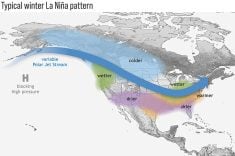Beginning next year, Big Brother will keep a closer watch on farmers who grow midge tolerant wheat.
Todd Hyra, western business manager for SeCan, said the midge tolerant stewardship team is taking steps to ensure that producers are properly managing midge tolerant wheat varieties.
Those steps will include random audits of farmers who sign stewardship agreements, an ongoing communication and education campaign, and reviews of a central database that tracks all certified seed sales and commercial production of midge tolerant wheat.
It’s hoped these measures will ensure that all midge tolerant wheat grown in Western Canada is planted with either certified seed or seed that is one generation removed from certified.
Read Also

Canadian Food Inspection Agency extends chronic wasting disease control program consultation deadline
Date extended for consultation period of changes to CWD program
“Most of the (monitoring) process will be involved with reviewing the database to look for abnormalities in (certified seed) purchase patterns,” said Hyra.
“If a midge tolerant wheat grower purchased seed in 2010 and then vanished from the database (for more than two years), that would raise flags.… But if they came back in 2012 and bought (certified seed) again, then they would be assumed to be filling the requirements of the stewardship agreement.
Midge tolerant wheat varieties contain a gene known as Sm1. It is the only gene known to protect wheat against midge damage.
The wheat industry is using what it calls an interspersed refuge system to prolong the effectiveness of the Sm1 gene. In that system, midge tolerant wheat seed must contain some wheat seeds that are susceptible to wheat midge and some that are resistant to the insect.
Resistant seeds usually make up 84 to 95 percent of the seed lot.
Susceptible seeds in a blend are known as the refuge variety.
Maintaining the refuge at five to 16 percent ensures that midge will continue to feed on susceptible plants.
All but a few insects would die if all plants in a field were midge resistant. The insects that survived would mate and create a new generation with tolerance to the Sm1 gene. The refuge is designed to slow the midge’s ability to develop resistance.
Ron DePauw, a wheat researcher from the Semi-Arid Prairie Agricultural Research Centre in Swift Current, Sask., said studies are trying to determine how the refuge component diminishes over time.
Scientists believe the amount of susceptible wheat in midge tolerant blends can fall below acceptable levels within two generations.
Feedback from growers who produce and sell the seed suggests refuge varieties diminish more quickly in areas with high midge pressure.
Seed growers must test representative samples of the seed they harvest to ensure the refuge component falls within an acceptable range.
Warren Kaeding, a seed grower from Churchbridge, Sask., said tests conducted on his midge tolerant wheat showed refuge levels can fall to nearly zero within a single generation under certain conditions.
“It all depends on the amount of midge that you’re experiencing in the area,” said Kaeding. “The first year we grew the breeder seed. We had a high degree of midge infestation.
“We actually sprayed all of our non-midge acres but we didn’t spray our midge (tolerant) plots.
“The first year was probably the worst for us because we had to submit samples … and we found out that the midge resistant wheat was good but that 10 percent refuge all of a sudden became close to nil.
“The midge resistant wheat had done its job but it (the insect) certainly had taken out the refuge part.”
Kaeding said refuge varieties would be adequate under normal conditions in crops grown with common seed that is one generation removed from certified.















